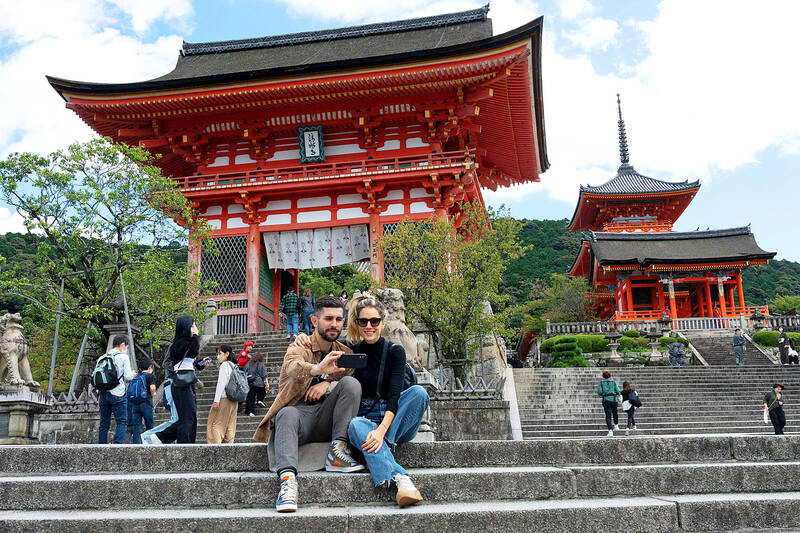Japan is already seeing an increase in inbound travelers since relaxing its COVID-19 border controls last week, but a full recovery would remain elusive until China opens up, the head of the country’s biggest international airport said.
Narita Airport chief executive officer Akihiko Tamura said a jump in overseas arrivals in Japan’s biggest international travel hub was an indication of this broader trend.
International arrivals have ticked up about 10 percentage points to about 30 percent of pre-COVID-19 pandemic levels since Japan reinstated visa-free travel to tourists on Tuesday last week, Tamura told reporters, citing airport research.

Photo: AFP
“To return to 2019 levels, it’s not enough just for Japan to open up,” he said. “Of course, China has to change as well or it’s impossible.”
Chinese visitors made up a sizeable portion of Narita’s volume until borders started clamping shut in 2020, Tamura said, adding that Beijing’s continuation of a “zero COVID-19” policy and Japan’s delayed reopening would push back a full recovery in East Asia travel to as late as 2025.
A record 9.5 million Chinese visited Japan in 2019, about one-third of all visitors, the national tourism agency said.
Japan last week threw open its doors to foreign visitors after more than two years of pandemic isolation, and is counting on tourism to help invigorate the economy and reap some benefits from the yen’s slide to a 32-year low.
However, the reverse effect of the weak yen is that it makes overseas travel more expensive for Japanese people, Tamura said.
Pent-up demand might be driving outbound bookings now, but the currency effect might drive domestic consumers to fly on low-cost carriers and stay at cheaper hotels overseas, he said.
Nearly half of Narita’s 260 shops and restaurants remain shuttered and it might take several months for many of them to reopen, due mainly to a staffing crunch, Tamura said.
“The last two to three years have been very damaging,” he said. “Quite a lot of people have left the airport and aviation industry, and the tourism sector nationwide, so it will take some time for them to return.”
About 70km from central Tokyo, or about an hour away via high-speed train, Narita Airport has ceded some ground in recent years to Haneda Airport, which lies much closer to the capital.
To boost business, Tamura said Narita needed to shift from being focused on Japanese consumers to offering a store lineup that serves overseas and transit travelers better.
Longer-term, the airport might need to pull together its three disparate terminals into one, more convenient hub, he added.

The US dollar was trading at NT$29.7 at 10am today on the Taipei Foreign Exchange, as the New Taiwan dollar gained NT$1.364 from the previous close last week. The NT dollar continued to rise today, after surging 3.07 percent on Friday. After opening at NT$30.91, the NT dollar gained more than NT$1 in just 15 minutes, briefly passing the NT$30 mark. Before the US Department of the Treasury's semi-annual currency report came out, expectations that the NT dollar would keep rising were already building. The NT dollar on Friday closed at NT$31.064, up by NT$0.953 — a 3.07 percent single-day gain. Today,

‘SHORT TERM’: The local currency would likely remain strong in the near term, driven by anticipated US trade pressure, capital inflows and expectations of a US Fed rate cut The US dollar is expected to fall below NT$30 in the near term, as traders anticipate increased pressure from Washington for Taiwan to allow the New Taiwan dollar to appreciate, Cathay United Bank (國泰世華銀行) chief economist Lin Chi-chao (林啟超) said. Following a sharp drop in the greenback against the NT dollar on Friday, Lin told the Central News Agency that the local currency is likely to remain strong in the short term, driven in part by market psychology surrounding anticipated US policy pressure. On Friday, the US dollar fell NT$0.953, or 3.07 percent, closing at NT$31.064 — its lowest level since Jan.

Hong Kong authorities ramped up sales of the local dollar as the greenback’s slide threatened the foreign-exchange peg. The Hong Kong Monetary Authority (HKMA) sold a record HK$60.5 billion (US$7.8 billion) of the city’s currency, according to an alert sent on its Bloomberg page yesterday in Asia, after it tested the upper end of its trading band. That added to the HK$56.1 billion of sales versus the greenback since Friday. The rapid intervention signals efforts from the city’s authorities to limit the local currency’s moves within its HK$7.75 to HK$7.85 per US dollar trading band. Heavy sales of the local dollar by

The Financial Supervisory Commission (FSC) yesterday met with some of the nation’s largest insurance companies as a skyrocketing New Taiwan dollar piles pressure on their hundreds of billions of dollars in US bond investments. The commission has asked some life insurance firms, among the biggest Asian holders of US debt, to discuss how the rapidly strengthening NT dollar has impacted their operations, people familiar with the matter said. The meeting took place as the NT dollar jumped as much as 5 percent yesterday, its biggest intraday gain in more than three decades. The local currency surged as exporters rushed to